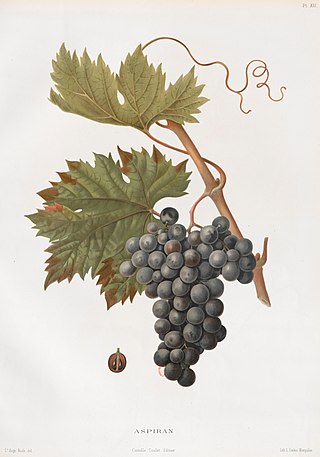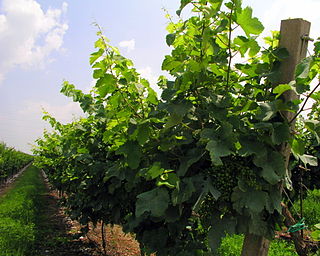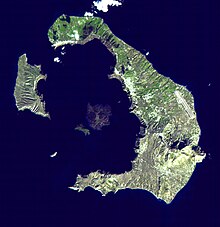
Syrah, also known as Shiraz, is a dark-skinned grape variety grown throughout the world and used primarily to produce red wine. In 1999, Syrah was found to be the offspring of two obscure grapes from southeastern France, Dureza and Mondeuse Blanche. Syrah should not be confused with Petite Sirah, a cross of Syrah with Peloursin dating from 1880.

Malvasia is a group of wine grape varieties grown historically in the Mediterranean region, Balearic Islands, Canary Islands and the island of Madeira, but now grown in many of the winemaking regions of the world. In the past, the names Malvasia, Malvazia, and Malmsey have been used interchangeably for Malvasia-based wines; however, in modern oenology, "Malmsey" is now used almost exclusively for a sweet variety of Madeira wine made from the Malvasia grape. Grape varieties in this family include Malvasia bianca, Malvasia di Schierano, Malvasia negra, Malvasia nera, Malvasia nera di Brindisi, Malvasia di Candia aromatica, Malvasia odorosissima, and a number of other varieties.

Agiorgitiko is a red Greek wine grape variety that, as of 2012, was the most widely planted red grape variety in Greece, ahead of Xynomavro. The grape has traditionally been grown in the Nemea region of the Peloponnese but can be found throughout the country including Attikí (Attica) and Makedonía (Macedonia).

Vitis labrusca, the fox grape, is a species of grapevines belonging to the Vitis genus in the flowering plant family Vitaceae. The vines are native to eastern North America and are the source of many grape cultivars, including Catawba, Concord, Delaware, Isabella, Niagara, and many hybrid grape varieties such as Agawam, Alexander and Onaka. Among the characteristics of this vine species in contrast to the European wine grape Vitis vinifera are its "slip-skin" that allows the skin of the grape berries to easily slip off when squeezed, instead of crushing the pulp, and the presence of tendrils on every node of the cane. Another contrast with European vinifera is the characteristic "foxy" musk of V. labrusca, best known to most people through the Concord grape. This musk is not related to the mammalian fox, but rather to the strong, earthy aromas characteristic of the grapes that were known by early European-American settlers in the New World. The term "foxy" became a sort of catchall for the wine tasting descriptors used for these American wines that were distinct from the familiar flavors of the European viniferous wines.
Lefko may refer to the following:

Torrontés is a white grape variety, mostly produced and known in Argentine wine, producing fresh, aromatic wines with moderate acidity, smooth texture and mouthfeel as well as distinctive peach and apricot aromas on the nose. Three Torrontés varieties exist in Argentina: Torrontés Riojano, the most common, Torrontés Sanjuanino, and Torrontés Mendocino. It is primarily Torrontés Riojano that has received attention for the quality of its wines, and is the variety used for most Argentine wines simply labeled Torrontés.

Tibouren or Rossese di Dolceacqua is a red French wine grape variety that is primarily grown in Provence and Liguria but originated in Greece and possibly even the Middle East. Intensely aromatic, with an earthy bouquet that wine expert Jancis Robinson describes as garrigue, Tibouren is often used in the production of rosés.
Ribolla Gialla is a white wine grape grown most prominently in the Friuli region of northeast Italy. The grape is also found in Slovenia where it is known as Rebula. In Friuli, the grape thrives in the region around Rosazzo and Gorizia. In Slovenia, the grape is grown prominently in the Brda region. The grape is not related to the Friuli red wine grape Schioppettino, which is also known as Ribolla Nera. The obscure, lower quality Ribola Verde grape is a mutated version that is not widely used.
Robola is a white Greek wine grape variety that is grown primarily on the Ionian island of Cephalonia. Historically the vine was thought to be the same variety as the Friuli wine grape Ribolla and was thought to have been brought to northeast Italy by Venetian merchants trading with Cephalonia in the 13th century. However, DNA profiling in the 21st century has cast doubt on that theory and today Robola is classified by the Vitis International Variety Catalogue (VIVC) as a separate variety.

Athiri or Athiri Aspro is a white Greek wine grape used to make Retsina on the island of Rhodes.
Arinto or Arinto de Bucelas is a white Portuguese wine grape planted primarily in the Bucelas, Tejo and Vinho Verde regions. It can produce high acid wines with lemon notes.
Malagousia or Malagouzia is a white Greek wine grape that was virtually extinct until Professor of Oenology Vassilis Logothetis re-discovered it in Nafpaktia and presented it to one of his students, Vangelis Gerovassiliou, in the 1970s. Experimental vinification began at the Porto Carras winery, and later continued on Vangelis Gerovassiliou's own estate. The grape is highly aromatic and has the potential to produce soft, elegant wines.
Vilana is a white Greek wine grape variety planted primarily in Crete. The grape is a difficult one to cultivate and produces delicate wines rarely seen outside Greece.

Aspiran is a red French wine grape variety planted primarily in the Languedoc where it permitted under Appellation d'origine contrôlée (AOC) regulations in the red and rosé wines of the Minervois AOC. Aspiran is a very old variety with a long history of producing light bodied and perfumed wines.
Limnio (LIM-nee-oh) is a red Greek wine grape variety that is indigenous to the Greek island of Lemnos. The grape has had a long history of wine production that may extend back to Ancient Greece with wine historians widely believing it was the grape variety, Lemnia, that was described by Aristotle as producing the famous red Lemnian wine. According to wine expert Oz Clarke, Limnio is "One of Greece's most important red vines."
Mandilaria is a red Greek wine grape variety that is grown throughout the Greek Isles. The grape is often used as a blending component, producing deeply colored wines that are light bodied.

Glera, also known as Prosecco, is a white variety of grape of Slovenian origin, which was brought to the Italian village of Prosecco from the Karst region. The variety was formerly mostly referred to as Prosecco, but in the EU was renamed "Glera" in 2009 to make room for the protection of "Prosecco" as the name of the Italian geographically-protected wine.
Rabo de Ovelha is white Portuguese wine grape variety that is grown all over Portugal. It should not be confused with the red Rabo de Anho grape variety that is found in the Vinho Verde region. Rabo de Ovelha is an authorized grape variety in the Bairrada, Borba, Bucelas, Redondo, Reguengos, Setúbal and Vidigueira Denominação de Origem Controlada (DOC). The grape variety gets its name from the way its grape bunches resembles the end of a ewe's tail. In winemaking, Rabo de Ovelha is known for producing highly alcoholic wines that wine expert Jancis Robinson describes as lacking subtlety.

Olmo grapes are wine and table grape varieties produced by University of California, Davis viticulturist Dr. Harold Olmo. Over the course of his nearly 50-year career, Dr. Olmo bred a wide variety of both grapes by means of both crossing varieties from the same species or creating hybrid grapes from cultivars of different Vitis species.

Wine Grapes - A complete guide to 1,368 vine varieties, including their origins and flavours is a reference book about varieties of wine grapes. The book covers all grape varieties that were known to produce commercial quantities of wine at the time of writing, which meant 1,368 of the known 10,000 varieties. It is written by British Masters of Wine Jancis Robinson and Julia Harding in collaboration with Swiss grape geneticist Dr. José Vouillamoz.











